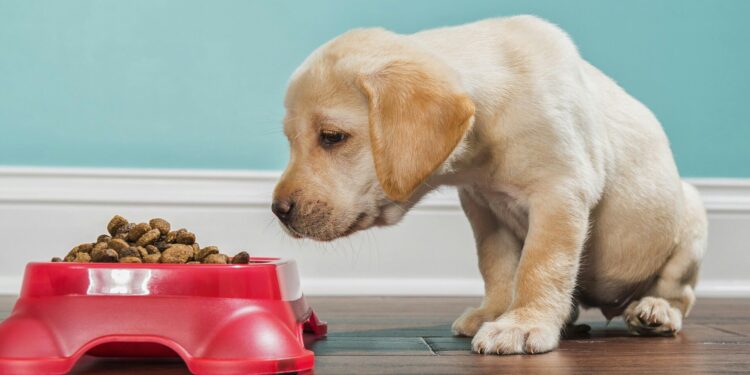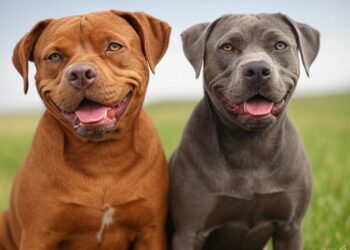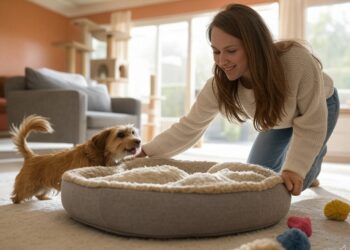Are you about to welcome a new family member into your home? If so, let’s check if you’re ready for their arrival! Below is a list of items needed for a puppy in the first months of life.
1. Bowls
Your dog will need two bowls: one for food and one for water. The bowls must be sturdy and suitable for the size of your pet (it’s more practical to buy bowls with some room for growth for a puppy). When choosing bowls, consider the specific breed characteristics of your dog.
There are several types of dog bowls:
Plastic Bowls
Inexpensive, lightweight and easy to clean. Suitable for toy and small dog breeds, as well as for puppies. Plastic bowls are not suited for active dogs since they are light and your pet will drag them over the floor while eating.
Plastic bowls can be single or double. Double bowls are more challenging to clean, but they take up less space.

Ceramic Bowls
The main advantage of ceramic dog bowls is their stability. Thanks to their weight, ceramic bowls do not tip over or roll across the floor.
Stainless Steel Bowls
These bowls are made of stainless steel and will last you and your pet for many years. For active dogs, special rubber-based bowls have been designed, which feature a non-slip rubber bottom. Those with a small kitchen will appreciate ergonomic bowls with a stand: they take up little space, are easy to clean, and have rubberized legs.
Some of the most modern bowls are stainless steel with adjustable stands. Like all metal bowls, they are very practical and durable. At the same time, they are very convenient for the dog: the solid stand prevents the bowls from sliding on the floor, and the sturdy attachment keeps them from tipping over.
Moreover, many dog experts believe that bowls should be positioned at the dog’s chest level, as this promotes proper posture development and prevents the swallowing of air. Such bowls are especially useful for puppies: adjustable bowls will “grow” as the dog matures, promoting proper spine development.
Silicone Bowls
Convenient and lightweight foldable silicone bowls that easily fit into the pocket of jeans, a backpack, or a purse. They are indispensable during long walks, while traveling, or at a dog show.
2. Food
Consult with the breeder or a veterinarian (or better yet, listen to the opinions of both!) about what to feed the puppy. Stock up on the necessary products or food so that the new family member always has fresh food available. We recommend feeding your dog premium-grade food.
3. Toys
Surely, when wondering “What does a puppy need?”, you’ve envisioned various toys. Toys for puppies aren’t just entertainment; they’re also a way for them to explore the world. Properly chosen toys will save your shoes and furniture and will help the puppy cope with loneliness while you’re away.
4. Sleeping and Resting Area
The puppy needs a place in the apartment to sleep and rest. Where this space is located depends not only on your choice, but also on the puppy’s preferences: the new family member may like to be the center of attention, or vice versa – he may want to rest where there is no close supervision. The main thing is to make sure your pup’s corner is soft, warm and comfortable!
Dog Mats
Dog beds are practical, foam-based beds for dogs. They are easy to roll up and can be taken on the road. The bed can be placed in a cage or carrier.
Dog Cushions
Dog cushions are a softer alternative to mats. Cushions can be used standalone or as a soft base for a plastic bed or a carrier.
Dog Baskets
Baskets are perfect for dogs that like to rest their heads on something while sleeping. Baskets come in both soft and hard varieties. In the second case, it’s best to use them with a soft cushion or blanket. When selecting a bed, consider the size (it is best for a puppy to get a bed “for growing up”). Beds with removable covers or that can be washed in the washing machine are more practical.
5. Gear
Before buying a leash or collar for your puppy, consult with your breeder or a specialist: find out which type of gear is best suited for a particular breed. Straps, for example, are not appropriate for all breeds; in fact, some are strongly discouraged. Likewise, not all dogs are comfortable being walked with a retractable leash, and so on.
When choosing a collar or straps for a puppy, pay attention to the material they are made from. For younger puppies, nylon or soft leather is ideal, while older puppies might benefit from canvas or rougher leather. If you have a larger breed, you’ll likely need to change the collar (or straps) or purchase one with a broad adjustable range so you can lengthen it as the puppy grows.
When choosing a retractable leash, consider its weight limit: it should cover not only the weight of your dog but also the force of its pull. For active, spirited dogs and growing puppies, it’s best to buy a retractable leash with some spare. For instance, for pugs we recommend using a leash for 20-25 kilograms, even though the average adult pug weighs between 8 and 12 kilograms.
When heading out for a walk with your puppy, don’t forget to attach an ID tag to their collar or harness. This tag should have information about the dog and its owner (name, address, phone number, etc.). This will help anyone who finds your pet to contact you.
During late evening walks, you might need glow-in-the-dark accessories (collars, leads, or tags). These will help you keep track of your pet in the dark and also make their movement through city streets safer.
6. Toilet
While your puppy is not allowed outdoors, or is just learning to go to the toilet, give him a special place at home where he can relieve himself. This could be an absorbent pee pad or a special dog toilet. Owners of toy or decorative breeds might find it more economical to invest in reusable pads, which can be washed in the washing machine.
You can buy reusable pee pads suitable for dogs. Potty Buddy’s unique design features multiple layers that work together to eliminate leakage and trap odors. Being soft, comfy, and distinctly patterned, your dog will naturally be attracted to using it.
7. Grooming Essentials
To ensure your puppy grows up healthy and beautiful, it’s vital to maintain their hygiene, care for their fur, regularly trim their nails, and clean their teeth, eyes, and ears. Specialized grooming products will assist you in this endeavor.
Shampoos
You should never wash a dog using human shampoo: the specific characteristics of a dog’s fur and skin are not considered in human shampoos! Only buy specialized dog shampoos for your pet. There’s a vast selection of puppy shampoos available.
As your pet matures, transition them to a shampoo tailored to the specific needs of their coat. For instance, there are shampoos made for dogs with black fur, for coarse-haired or short-haired breeds.
For long-haired dogs, besides shampoo, it’s essential to use a conditioner or a specific detangling spray.
Nail Clippers
A nail clipper is a tool specifically designed for trimming nails. For smaller dog breeds, you can use scissors, while for larger dogs, guillotines or secateurs are more suitable. If you’re hesitant or anxious about trimming your dog’s nails yourself, take them to a grooming salon or a veterinary clinic.
Combs, Brushes, and Undercoat Rakes
The necessary tools for fur care depend on your dog’s breed.
Short-haired dogs typically require just a weekly combing using a brush or an undercoat rake. The choice of an undercoat rake (or brush) should be based on your dog’s skin and fur type. Stiff-haired dogs might benefit from grooming tools with stiff bristles, such as metal undercoat rakes.
For dogs with delicate skin, rubber brushes or soft brushes with nylon bristles are preferable. Caring for a long-haired dog will demand the use of specialized combs and mat splitters. Dog combs vary in size (standard or mini) and tooth spacing (sparse or dense).
Furminator for Dogs
If your puppy has an undercoat, a Furminator is indispensable – it’s an American tool designed for undercoat removal that can reduce shedding by up to 90%. You can learn more about this tool and its benefits in an article about Furminators.
8. First Aid Kit
In addition to the phone number of the breeder or a familiar specialist, you should always have on hand the numbers of nearby veterinary clinics, veterinarians who make house calls, and 24-hour veterinary hospitals. Make sure to prepare a dog first aid kit containing essential medications and remedies that may be needed for treating your puppy or providing them with first aid.
- Thermometer, dropper, enema;
- Cotton wool, bandages, adhesive plasters, wraps;
- Several syringes of different volumes;
- Disinfectants
- Medicinal chamomile, activated charcoal (for digestive disturbances);
- Wound antiseptics
We recommend expanding the list with medications specifically needed for your dog breed. For instance, for “anxious” breeds, it’s suggested to keep Nutracalm on hand.
Adopting a dog is a very responsible act! The new family member will require much attention and patience from you. To ensure that training your dog brings you joy, and to ensure your pet’s mood is always high and its health in top condition, make preparations in advance for everything a puppy might need at the beginning of its life! Without a doubt, your puppy will repay your care with its love and loyalty!








